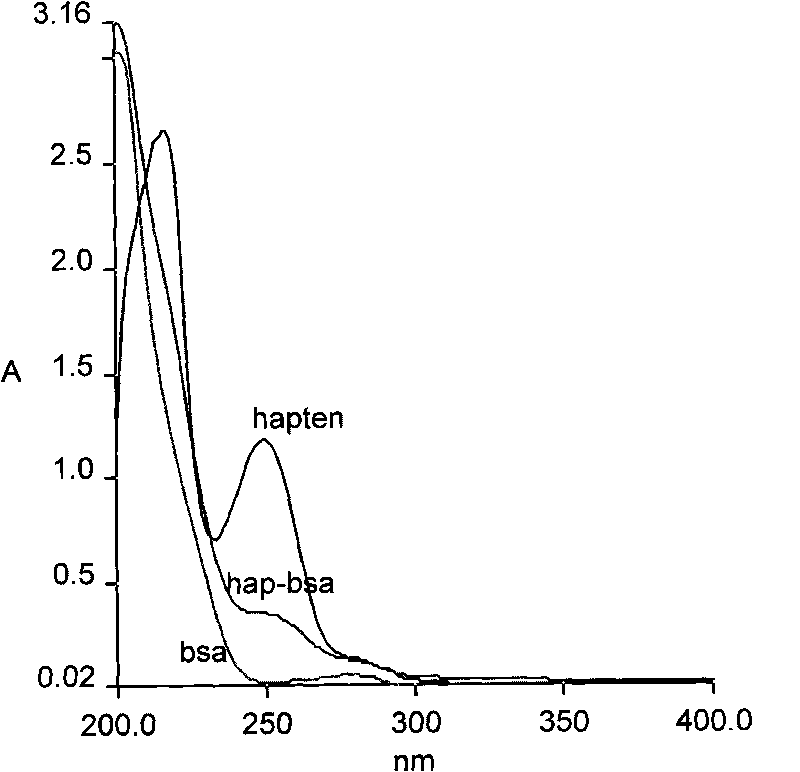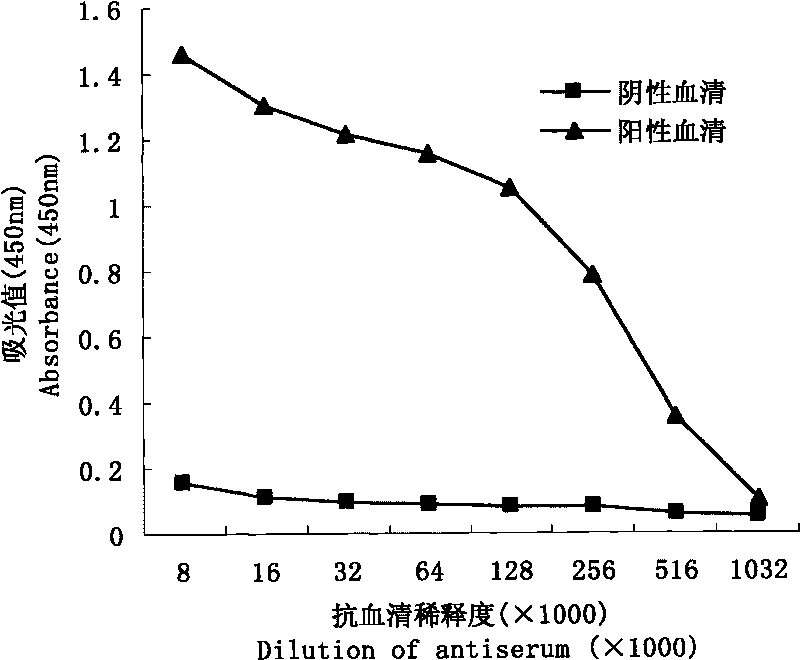Polyclonal antibody of dimethachlon and preparation and application thereof
A polyclonal antibody and sclerotium purification technology, which is applied in the preparation methods of peptides, chemical instruments and methods, animal/human proteins, etc., can solve the problems of low detection efficiency and single detection method, and achieve low detection cost and detection method. Simple, simple preparation method
- Summary
- Abstract
- Description
- Claims
- Application Information
AI Technical Summary
Problems solved by technology
Method used
Image
Examples
Embodiment 1
[0023] Example 1. Synthesis of immune antigen and coating antigen
[0024] Synthesize immune antigen by active ester method: weigh 21mg (0.0583mmol) hapten and dissolve it in 0.4mL dimethylformamide (DMF), then add N-hydroxysuccinimide (NHS) 7.17mg (0.0623mmol) and Cyclodihexylcarboimide (DCC) 13.76mg (0.0667mmol), mix thoroughly, and stand at room temperature overnight in the dark. The next day, centrifuge at 10000g for 10min, discard the precipitate, slowly add the supernatant to 3mL of borate buffer (pH8.7) containing 25mg (0.00037mmol) bovine serum albumin BSA, and continue magnetically stirring the reaction solution for 4 hours at room temperature . After the reaction, put the reaction mixture into a dialysis bag, dialyze in deionized water at 4°C for 3 days, change the water every 8 hours, obtain the immune antigen Hapten-BSA after the dialysis, divide it and store it in a -20°C refrigerator in spare.
[0025] The synthesis method of the coating antigen Hapten-OVA by ...
Embodiment 2
[0027] Example 2. Preparation of Sclerotin polyclonal antibody
[0028] The synthetic conjugate was used as the immune antigen Hapten-BSA, and two purebred New Zealand white rabbits of 1.5-2.0 kg were selected as experimental animals, and negative serum was collected one week before the experiment. The specific immunization procedures are shown in Table 1: For the first immunization, each rabbit was immunized with 1 mg of immunogen mixed with an equal volume of Freund's complete adjuvant, emulsified into a water-in-oil emulsion, and injected subcutaneously at multiple points on the back (around 20 o'clock). Three weeks later, the same dose of immunogen and an equal volume of incomplete Freund's adjuvant were used to boost, once every two weeks, for a total of 4 times. When the serum titer basically no longer rises, shock immunization is carried out, and 2 mg of immunogen is mixed with an equal volume of normal saline, and injected directly into the ear vein. A week later, blo...
Embodiment 3
[0031] Example 3. Indirect non-competitive ELISA method for determining the working concentration and titer of antibodies
[0032] (1) Determination of working concentration
[0033] Determine the working concentration of antibody and coated antigen by square array titration. Select the dilution concentration of the antigen and antibody when the OD value is 1.0 as the working concentration of the coated antigen and antibody. The working concentration is 1 / 128000. The specific operation steps are as follows:
[0034] ① Coating: CBS coating buffer will coat the four groups of antigens diluted 100×5n (n=0.5, 1, 2, 4), and add them to A, B, and C of the 96-well enzyme-labeled microplate respectively. And D, E and F, G and H in four groups of eight rows, 100 μL / well, 4°C overnight.
[0035] ② Blocking: Add 200 μL of 1% OVA blocking solution to each well, and incubate at 37°C for 1 hour.
[0036] ③Adding samples: Add six groups of antibodies with a doubling dilution of 1000×2n ...
PUM
 Login to View More
Login to View More Abstract
Description
Claims
Application Information
 Login to View More
Login to View More - Generate Ideas
- Intellectual Property
- Life Sciences
- Materials
- Tech Scout
- Unparalleled Data Quality
- Higher Quality Content
- 60% Fewer Hallucinations
Browse by: Latest US Patents, China's latest patents, Technical Efficacy Thesaurus, Application Domain, Technology Topic, Popular Technical Reports.
© 2025 PatSnap. All rights reserved.Legal|Privacy policy|Modern Slavery Act Transparency Statement|Sitemap|About US| Contact US: help@patsnap.com



